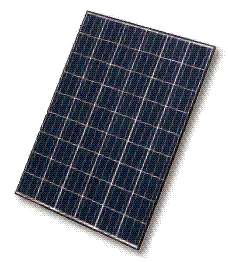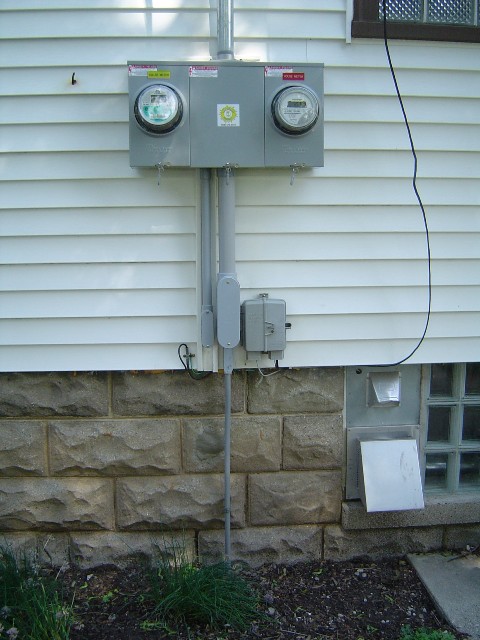House Roof
 Sunlight shines on each photovoltaic cell of each panel in the array and is converted to electricity. Direct sunlight shining perpendicular to the panel is best, but indirect sunlight or lower incident angles will also generate electricity. If one string of cells is generating much less power than nearby strings of cells (i.e. a partly shaded panel), blocking diodes prevent the sunlit cells' power from feeding back into the shaded cells, but this reduces the overall voltage created by the array. The amount of current generated is proportional to the intensity of sunlight. Each panel is wired in series with the others, so their voltages add together. This maximizes power while keeping the total current low, which minimizes transmission line losses.
Sunlight shines on each photovoltaic cell of each panel in the array and is converted to electricity. Direct sunlight shining perpendicular to the panel is best, but indirect sunlight or lower incident angles will also generate electricity. If one string of cells is generating much less power than nearby strings of cells (i.e. a partly shaded panel), blocking diodes prevent the sunlit cells' power from feeding back into the shaded cells, but this reduces the overall voltage created by the array. The amount of current generated is proportional to the intensity of sunlight. Each panel is wired in series with the others, so their voltages add together. This maximizes power while keeping the total current low, which minimizes transmission line losses.
Basement
 DC power from the east and west sides of the solar array go through the two disconnect switches on the right and then up into the inverter. The inverter uses pulse-width modulation to find the maximum power point for each side of the array and converts the power to AC (nominally 240 VAC, 60 Hz, true sine wave). AC power from the inverter goes down out of the inverter, through another disconnect switch, and out the west wall of the basement to the meter. The LCD panel in the lower-right corner of the inverter displays the current performance of each side of the array, the output power being provided to the grid, and historical statistics showing power generated over time.
DC power from the east and west sides of the solar array go through the two disconnect switches on the right and then up into the inverter. The inverter uses pulse-width modulation to find the maximum power point for each side of the array and converts the power to AC (nominally 240 VAC, 60 Hz, true sine wave). AC power from the inverter goes down out of the inverter, through another disconnect switch, and out the west wall of the basement to the meter. The LCD panel in the lower-right corner of the inverter displays the current performance of each side of the array, the output power being provided to the grid, and historical statistics showing power generated over time.
(The big box on the left is the main breaker panel for the house.)
Meters
 Power from the inverter comes out of the basement and up to the left meter (which displays the total amount of the power that has been generated since the system became operational). Then the power flows to the central junction box, from where it flows through the right meter (which display the total amount
of power that has been used in our house), back into the basement, and into the main breaker panel. When I am generating more power than I'm using, surplus power flows from the central junction, up the mast, and out to the utility grid. When I'm a net consumer, the additional power I need flows in from
the grid.
Power from the inverter comes out of the basement and up to the left meter (which displays the total amount of the power that has been generated since the system became operational). Then the power flows to the central junction box, from where it flows through the right meter (which display the total amount
of power that has been used in our house), back into the basement, and into the main breaker panel. When I am generating more power than I'm using, surplus power flows from the central junction, up the mast, and out to the utility grid. When I'm a net consumer, the additional power I need flows in from
the grid.
(The small conduit running down the wall to the ground is the grounding wire that protects the solar installation and the house power distribution system.)
 Sunlight shines on each photovoltaic cell of each panel in the array and is converted to electricity. Direct sunlight shining perpendicular to the panel is best, but indirect sunlight or lower incident angles will also generate electricity. If one string of cells is generating much less power than nearby strings of cells (i.e. a partly shaded panel), blocking diodes prevent the sunlit cells' power from feeding back into the shaded cells, but this reduces the overall voltage created by the array. The amount of current generated is proportional to the intensity of sunlight. Each panel is wired in series with the others, so their voltages add together. This maximizes power while keeping the total current low, which minimizes transmission line losses.
Sunlight shines on each photovoltaic cell of each panel in the array and is converted to electricity. Direct sunlight shining perpendicular to the panel is best, but indirect sunlight or lower incident angles will also generate electricity. If one string of cells is generating much less power than nearby strings of cells (i.e. a partly shaded panel), blocking diodes prevent the sunlit cells' power from feeding back into the shaded cells, but this reduces the overall voltage created by the array. The amount of current generated is proportional to the intensity of sunlight. Each panel is wired in series with the others, so their voltages add together. This maximizes power while keeping the total current low, which minimizes transmission line losses.
 DC power from the east and west sides of the solar array go through the two disconnect switches on the right and then up into the inverter. The inverter uses pulse-width modulation to find the maximum power point for each side of the array and converts the power to AC (nominally 240 VAC, 60 Hz, true sine wave). AC power from the inverter goes down out of the inverter, through another disconnect switch, and out the west wall of the basement to the meter. The LCD panel in the lower-right corner of the inverter displays the current performance of each side of the array, the output power being provided to the grid, and historical statistics showing power generated over time.
DC power from the east and west sides of the solar array go through the two disconnect switches on the right and then up into the inverter. The inverter uses pulse-width modulation to find the maximum power point for each side of the array and converts the power to AC (nominally 240 VAC, 60 Hz, true sine wave). AC power from the inverter goes down out of the inverter, through another disconnect switch, and out the west wall of the basement to the meter. The LCD panel in the lower-right corner of the inverter displays the current performance of each side of the array, the output power being provided to the grid, and historical statistics showing power generated over time.